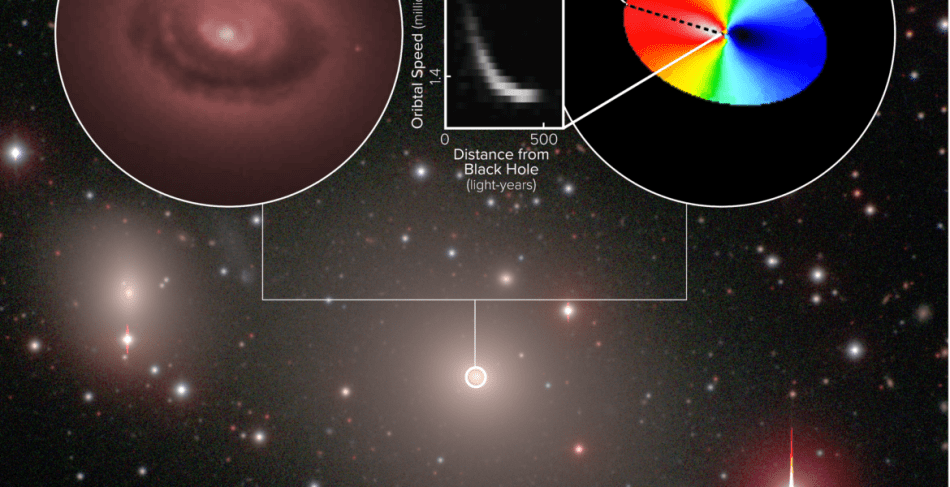Aug 8 2019
What occurs inside a black hole stays inside a black hole, but what takes place within a black hole’s “sphere of influence”—the innermost region of a galaxy where a black hole’s gravity is the central force—is of deep interest to astronomers and can help establish the mass of a black hole as well as its influence on its galactic neighborhood.
 (Image credit: ALMA (ESO/NAOJ/NRAO), B. Boizelle; NRAO/AUI/NSF, S. Dagnello; Hubble Space Telescope (NASA/ESA); Carnegie-Irvine Galaxy Survey)
(Image credit: ALMA (ESO/NAOJ/NRAO), B. Boizelle; NRAO/AUI/NSF, S. Dagnello; Hubble Space Telescope (NASA/ESA); Carnegie-Irvine Galaxy Survey)
New observations using the Atacama Large Millimeter/submillimeter Array (ALMA) offer an unparalleled close-up view of a swirling disk of cold interstellar gas circling around a supermassive black hole. This disk can be located at the center of NGC 3258, an enormous elliptical galaxy about 100 million light-years from Earth.
Based on these observations, a team directed by astronomers from Texas A&M University and the University of California, Irvine, have established that this black hole weighs an astounding 2.25 billion solar masses, the most enormous black hole measured using ALMA to date.
Though supermassive black holes can contain masses that are millions to billions of times that of the Sun, they make up for just a small fraction of the mass of a whole galaxy. Separating the impact of a black hole’s gravity from the interstellar gas, stars, and dark matter in the galactic center is difficult and requires very sensitive observations on extraordinarily small scales.
“Observing the orbital motion of material as close as possible to a black hole is vitally important when accurately determining the black hole’s mass.” said Benjamin Boizelle, a postdoctoral researcher at Texas A&M University and lead author on the study appearing in the Astrophysical Journal. “These new observations of NGC 3258 demonstrate ALMA’s amazing power to map the rotation of gaseous disks around supermassive black holes in stunning detail.”
Astronomers use several techniques to measure black hole masses. In giant elliptical galaxies, a number of measurements arise from observations of the orbital motion of stars around the black hole, taken in infrared or visible light. Another method, applying naturally occurring water masers (radio-wavelength lasers) in gas clouds orbiting around black holes, offers higher precision, but these masers are very sporadic and are related almost completely with spiral galaxies having smaller black holes.
In the last few years, ALMA has established a new technique to investigate black holes in massive elliptical galaxies. About 10% of elliptical galaxies comprise recurrently rotating disks of cold, dense gas at their centers. These disks hold carbon monoxide (CO) gas, which can be detected with millimeter-wavelength radio telescopes.
By employing the Doppler shift of the emission from CO molecules, astronomers can calculate the velocities of circling gas clouds, and ALMA makes it achievable to resolve the very centers of galaxies where the orbital speeds are maximum.
Our team has been surveying nearby elliptical galaxies with ALMA for several years to find and study disks of molecular gas rotating around giant black holes. NGC 3258 is the best target we’ve found, because we’re able to trace the disk’s rotation closer to the black hole than in any other galaxy.
Aaron Barth, Study Co-Author, UC Irvine
Similar to how the Earth orbits around the Sun faster than Pluto does because it is exposed to a stronger gravitational force, the inner regions of the NGC 3258 disk orbit faster than the outer parts because of the black hole’s gravity. The ALMA data reveals that the disk’s rotation speed increases from 1 million kilometers per hour at its outer edge, about 500 light-years from the black hole, to more than 3 million kilometers per hour near the disk’s center at a distance of just 65 light-years from the black hole.
The scientists established the black hole’s mass by modeling the disk’s rotation, making up for the extra mass of the stars in the galaxy’s core region and other details such as the somewhat warped shape of the gaseous disk. The strong detection of fast rotation allowed the team to establish the black hole’s mass with a precision better than 1%, although they approximate an extra systematic 12% ambiguity in the measurement because the distance to NGC 3258 is not known exactly. Even accounting for the ambiguous distance, this is one of the extremely precise mass measurements for any black hole beyond the Milky Way galaxy.
The next challenge is to find more examples of near-perfect rotating disks like this one so that we can apply this method to measure black hole masses in a larger sample of galaxies. Additional ALMA observations that reach this level of precision will help us better understand the growth of both galaxies and black holes across the age of the universe.
Benjamin Boizelle, Study Lead Author and Postdoctoral Researcher, Texas A&M University
The National Radio Astronomy Observatory is a facility of the National Science Foundation, run under cooperative agreement by Associated Universities, Inc.